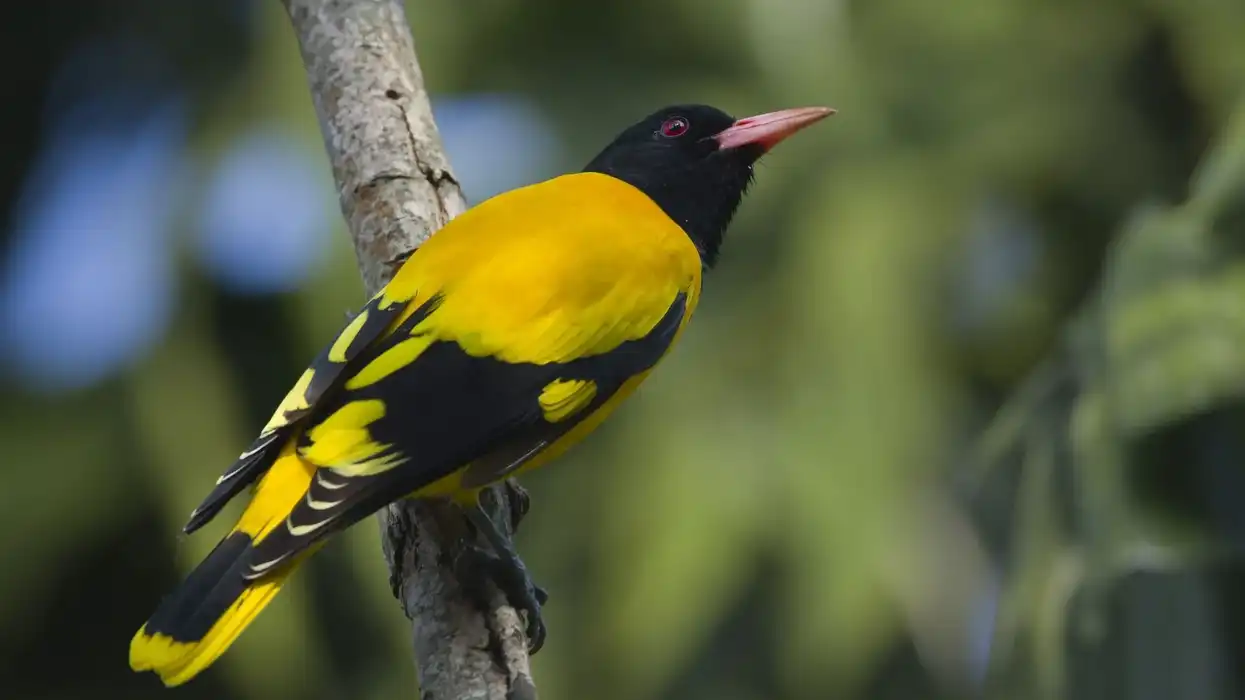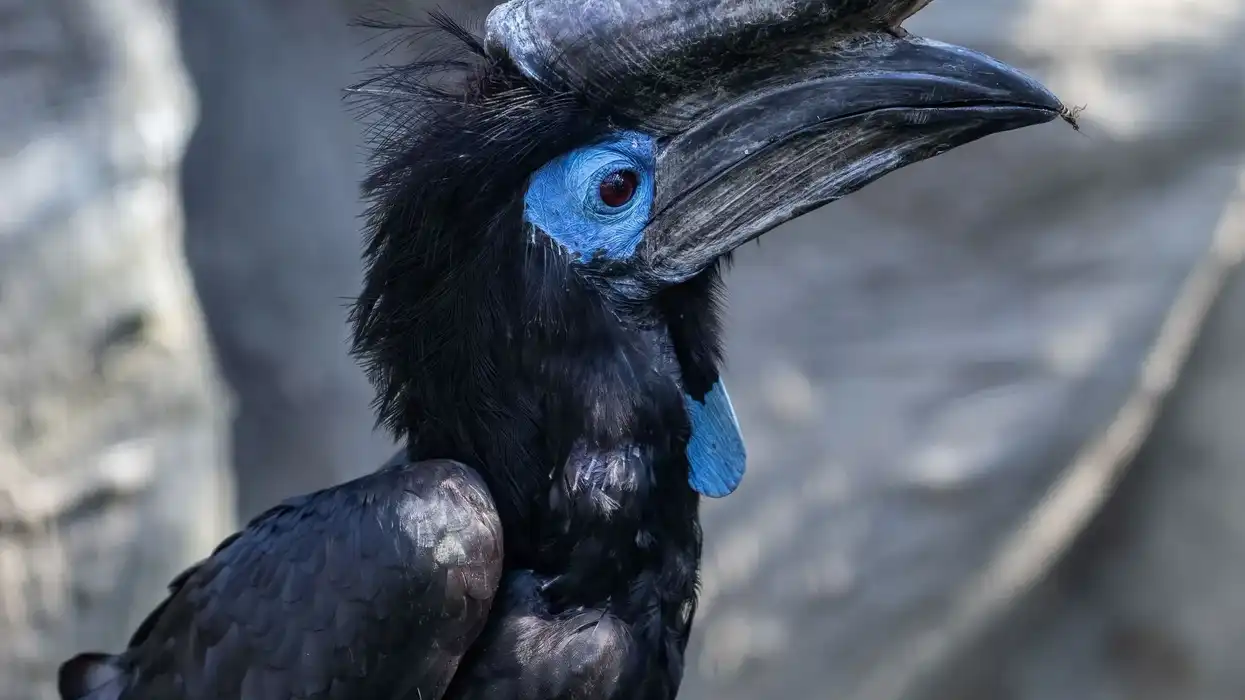The Great Black Hawk is a raptor and a bird of prey that comes from the hawk family of predatory birds. It is similar to the Common Black Hawk (Buteogallus anthracinus), but a bit larger and heavier with a different call and tail pattern.
It is found mainly in the Neotropics, in Mexico and Central America to Peru, Northern Argentina, Tobago, and Panama, and rarely in North America. The Great Black Hawk feeds mainly on reptiles and large insects.
Apart from diving and swooping to its prey, it also hunts on foot sometimes. It is 22-25.2 in (56-64 cm) long and weighs 2.4-2.9 lb (1.1-1.3kg).
It has a striking appearance with largely black features which include its broad wings, plumage, beak, and tail.
The tail pattern has a bit of white, its eyes are dark brown, and its legs are yellow. The young are much browner than an adult Great Black Hawk.
The female of the species tends to be larger than the males. The average clutch size is 1-2, and apart from the breeding season, the Great Black Hawk is a creature of solitude.
Great Black Hawk Interesting Facts
What type of animal is a great black hawk?
A Great Black Hawk is a bird (hawk), part of the Aves family.
What class of animal does a great black hawk belong to?
The Great Black Hawk (Buteogallus urubitinga) belongs to the Aves class of animals in the Animalia kingdom.
How many great black hawks are there in the world?
The exact number is unknown, but since the species is classified as one of 'Least Concern' by the IUCN, there are more than 10,000 mature individuals in the world, in South, Central, and North America.
Where does a great black hawk live?
The Great Black Hawk lives in the open woodlands near water, and sometimes on forest patches in Savannahs.
What is a great black hawk's habitat?
A Great Black Hawk is always found near water, more commonly inland water, rather than coastal. It is found in woodlands that are open or swampy or both.
A Great Black Hawk lives between elevations of sea level to about 5300 ft (1600 m). It is also known to live, less commonly in savannahs with forest patches and also near forest edges itself.
Who do great black hawks live with?
Outside of the breeding season, the Great Black Hawk lives alone.
How long does a great black hawk live?
The Great Black Hawk can live up to 24 years.
How do they reproduce?
A Great Black Hawk reproduces by mating with other Great Black Hawks. It builds nests about 20 feet above the ground with strong sticks.
After mating, a female will lay one or sometimes two eggs that are white but have dark spots, in the nest, and incubate for around 40 days. After a young hawk has hatched, the adult parents will bring the food until it can fly.
What is their conservation status?
The Conservation Status of the Great Black Hawk as classified by the International Union for Conservation of Nature is 'Least Concern'.
Great Black Hawk Fun Facts
What does a great black hawk look like?

A Great Black Hawk is considered to be a big, heavy bird with fairly long legs. The whole body of the Great Black Hawk is covered with black feathers (or plumage). Its tail is short and the tail pattern is black with a white bottom part.
When flying, its broad wings show shades of white and gray. Its head and hooked bill are also black, with a little yellow cere.
The talons and legs are also yellow, and their lives can be grayish or yellow. The eyes of a Great Black Hawk are dark brown. They look very much the same but females tend to be slightly bigger than males.
How cute are they?
Great Black Gawks can be thought of as very cute and beautiful creatures. Like other raptors, such as many eagles and big owls, the Great Black Hawk has a regal beauty about it. It is a predator that is only aggressive if its nest is threatened, and it looks especially beautiful when it spreads its big wings and soars.
How do they communicate?
Great Black Hawks are known to utter a high-pitched whistle or a scream which sounds like 'ooo-wheeeeeeuur'. It makes this sound when perching or flying.
How big is a great black hawk?
A Great Black Hawk weighs about 2.4-2.9 lb (1.1-1.3 kg), is 22-25.2 in (56-64 cm) long, and has a wingspan of 47-54 in (120-137 cm). It is 2-3 times bigger than the sharp-shinned hawk.
How fast can a great black hawk fly?
The Great Black Hawk can have airspeeds of up to 150 mph (241.4 kph).
How much does a great black hawk weigh?
A Great Black Hawk weighs about (2.4-2.9 lb (1.1-1.3 kg)
What are the male and female names of the species?
A male of a hawk species may be called a tiercel, and a female hawk is a hen.
What would you call a baby great black hawk?
A baby Great Black Hawk would be called an eyas.
What do they eat?
Great Black Hawks are carnivorous predators who eat anything from birds, small mammals, reptiles, lizards, fish, snakes, crabs, carrion, large insects, and poultry.
Are they dangerous?
Great Black Hawks are dangerous to the animals that they feed on. As far as humans are concerned, Great Black Hawks don't usually act with hostility towards humans unless their nests are threatened.
Would they make a good pet?
Great Black Hawks would not make a good pet, because they are wild creatures and top predators. They would not prefer being touched or petted, and even in the wild, they are creatures of solitude, except during the breeding season. They are exceptional hunters at heart and would never become cuddly pets.
Also in several places, especially the US, it is not legal to have them as pets, unless you are a professional falconer. A professional falconer has to have a license, pass an exam, and jump through a lot of hoops to keep a hawk, which includes building special housing for it.
Did you know...
The Great Black Hawk belongs to the family Accipitridae which includes other birds of prey such as Eagles, Hawks, and Vultures. It looks almost identical to the common Black Hawk, which is also a species of Least Concern.
The tail of the Great Black Hawk is said to be black with white bands in it, but it can be alternatively said that its short tail is white with a broad black tip. The bill is black and sharp.
The Great Black Bill can be said to be a resident breeding bird of the 'New World'.
New World is a term that was used to refer to the American continents in the Western Hemisphere. As a resident bird in the tropical American landmass, the Great Black Hawk Hawk survives near inland waters.
Great Black Hawks are found in North America in Mexico and Tobago and South America in Peru and Northern Argentina.
Great Black Hawks like feeding on small invertebrates in the water. It also likes feeding largely on reptiles on the ground.
August has been a peculiar month for vagrants of the Great Black Species. In August 1972, a vagrant was spotted in Virginia Key in Dade County. In August 2017, a vagrant was spotted in Biddeford, Maine.
The closely related Common Black Hawks have black beaks, and the legs are yellow, like the Great Black Hawk.
The nest of a Great Black is particularly sturdy with strong sticks carried by both males and females. When a young hatch from the egg, snakes and other such food is brought to the nest for it to feed on.
Although one of its habitats Tobago is closer to South America than North, it is considered to be a part of North America since it is part of the Caribbean islands. Mexico, another prominent habitat also falls officially under North America.
Another bird, which looks very similar to the Great Black Hawk is the Solitary Eagle or the Black Solitary Eagle, often identified incorrectly as the Common Black Hawk or the Great Black Hawk.
What is special about Hawks?
Hawks are massively powerful birds. Their vision is one of the best among all animals, being able to spot small animals from as high as one mile away. They can dive and fly at about 120 mph and swoop down to catch their prey with their strong talons, and they use their sharp beaks for eating.
Are there Black Hawks in Florida?
There have been only a few sightings of a Black Hawk in Florida, in the city of Miami. It is unusually rare even though Southern Florida is, technically, the Northern edge of the Black Hawks' range.
If it is found in Florida, it would be near the marshes or forest areas. Great Black Hawks can be spotted much more easily in Central or South America than in North America.
Here at Kidadl, we have carefully created lots of interesting family-friendly animal facts for everyone to discover! Learn more about some other birds including flamingos or black-billed cuckoos.
You can even occupy yourself at home by drawing one on our Great Black Hawk coloring pages.









